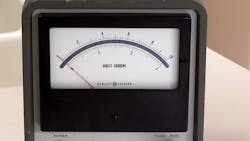This file type includes high-resolution graphics and schematics when applicable.
I received a very nice letter from Jim Samuels, an engineer at Carestream Health Inc. He talks about how Bob Pease helped him out on a visit to Silicon Valley. Samuels writes:
“I was reading some of your Bob Pease articles, enjoying not only Bob’s perspective on analog engineering, but also your own observations. Two items; first, Bob was a very kind individual (nothing new to you). I met him several times in his seminars around the country. I was flying out to California and asked Bob for surplus electronics stores to visit and he asked for my address. Before long I was copied in on an email to his friends in Silicon Valley explaining my upcoming trip and asking for their recommendations on top of his own. I was working at Eastman Kodak at the time and wished I had kept the email, as it was a veritable list of who's-who in the electronics industry, including Jim Williams. I printed off the list and enjoyed many hours at the surplus stores while I was out there.
“Secondly, you spoke of Bob’s fondness of analog meters in instrumentation. We rescued an analog meter coworkers were going to throw out. It was an HP Model 428B clamp-on DC milliammeter. We used it in the design of a chemical mixer. The analog meter monitored the DC-powered mixing pump from Gorman-Rupp. The meter’s needle movement showed us immediately how well the pump was mixing. A smooth needle movement showed that the magnetic-coupled rotor was spinning properly. A smooth but hesitant needle movement showed us that there was contamination in the fluid. A needle movement that would start out then drop back to zero characterized a decoupling of the magnetic rotor, indicating debris clogging the pump head. None of these conditions are as easily observed with a digital number display. Bob and others had it right; use the appropriate tool for the task at hand.
“Thanks again for your accurate (he is smiling) articles on Bob Pease.”
Jim Samuels, Carestream Health Inc. (formerly Kodak Health Imaging)
Well dang Jim, you sure cheered up my day. I do feel blessed that I got to know and be friends with Bob Pease. Some people at National Semiconductor just didn't seem to “get” Bob. He would copy some email encounter with a customer onto the back of used copies he salvaged from the wastebasket. He would go around handing them out to various folks. I was one of those folks, since he met me at conferences before I was hired into National Semi, and we seemed to click.
I would write Pease back, talking about my take on whatever he was writing about. Sometimes he would talk about automotive speed control, which I worked on at Ford. I would tell him about “porpoising,” where you are towing a trailer with cruise control engaged and when you go downhill, the trailer momentum starts to interact with the speed control and causes surging. He loved hearing about that, and included it in his thinking on servo control.
I don't suppose you were the box-camera part of Kodak, which National Semiconductor did a chip for, but it did not matter to Pease if you were a customer. If you were an engineer in need, Bob would help out. Some engineers (and managers) did not get this. They thought application engineers should only help big customers that could offer instant payback when they used National's chips. Bob did not care if you were using two chips or a million, or no chips. He would always be willing to help out, as long as you had done your homework.
I think one of the very important things about Bob is that he not only was a semiconductor engineer, he started his life as a systems engineer. Those discrete op amps he designed at Philbrick had tubes, and resistors, and capacitors. So Bob understood the problems of manufacturing repeatable circuits, and the design of robust circuits that worked every time for decades. He was truly one of a kind. It’s the fifth anniversary of Bob Pease’s death, and your kind note reminded me how much I miss him.
NOW AVAILABLE for download: An eBook from the Electronic Design Library: Bob Pease on Analog.
Click here.
Looking for parts? Go to SourceESB.
This file type includes high-resolution graphics and schematics when applicable.
About the Author

Paul Rako
Creative Director
Paul Rako is a creative director for Rako Studios. After attending GMI (now Kettering University) and the University of Michigan, he worked as an auto engineer in Detroit. He moved to Silicon Valley to start an engineering consulting company. After his share of startups and contract work, he became an apps engineer at National Semiconductor and a marketing maven at Analog Devices and Atmel. He also had a five-year stint at EDN magazine on the analog beat. His interests include politics, philosophy, motorcycles, and making music and videos. He has six Harley Sportsters, a studio full of musical instruments, a complete laboratory, and a video set at Tranquility Base, his home office in Sun City Center Florida.



